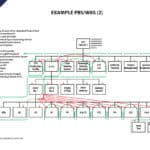- always state assumptions in relation to each cost estimate and each schedule estimate. In reviewing initially, and in reviewing as the program evolves, test/retest the assumptions.
- align responsibility and authority of teams, and individuals in leadership roles.
- programs and projects within a enterprise inevitably rely on common services. If services, such as financial accounting, human resource management, purchasing, configuration management are already mature and effective, place them within the enterprise architecture. If they are not, place them within the program/project architecture.
- establish process specialist cells within the enterprise, eg., project management, systems engineering, software engineering, logistics support analysis, quality control. If these exist and are mature and effective, place them within the enterprise architecture. If they are not, place them within the program/project architecture.
- place responsibility for quality control at the level of each individual.
- place responsibility for quality assurance of project deliverables outside of each project/program organization.
- create a vision for the project, and verifiable project success criteria. Share the vision and the success criteria with all project staff and supporting organizations.
- communicate the project vision and the success criteria from the top.
- trust people to do the jobs they are paid to do. If they do so, reward them. If they do not do so, move them within a set of constraints.
- if constraints inhibit success, try to remove the constraints.
- measure, measure, measure, from the first few minutes of project activity to the last.

Integrating Program Management and Systems Engineering
The benefits of integrating systems engineering principles with project management philosophies are
well established. Why then is it so difficult to achieve an integrated approach? How can we further strengthen and […]












